Verification of the Perception of the Local Community concerning Air Quality Using ADMS-Roads Modeling
Abstract
:1. Introduction
- Description of an original method for inner differentiation of a city in terms of air quality, using data on road traffic and taking into account the opinions of the inhabitants.
- Verification of the described method in one of the major cities of Poland by:
- Demarcation of those areas of the city which have been indicated as the best and the worst by the people well acquainted with the analyzed space in the air quality perception survey.
- Modeling the level of air pollution with NO2 emitted by the road transport by means of advanced GIS technologies and air pollution modeling software.
- Checking whether the respondents participating in the study of air quality perception properly assessed the city space, and whether they are aware of the factors which affect it negatively.
2. Materials and Methods
2.1. Study Area
2.2. Research Methodology and Data
- Analysis of source materials in the field of air quality in Kielce city, including data from the Copernicus Sentinel-5P satellite using the Google Earth Engine platform, data from the Provincial Inspectorate for Environmental Protection (Polish institution dealing with air quality in the city of Kielce), and data from the air quality monitoring system in Kielce, established in 2020 as part of the “Kielce without smog” [44] and “Smog Kielce” [45] projects.
- Performing a survey among experts in Kielce (the people closely familiar with Kielce and with knowledge about air quality and the impact of pollution on human health) in order to identify research areas which can be considered to be those with bad and good air quality. The results of the surveys were processed using the quantitative method for studying the assessment of air quality perception—semantic differential (SD).
- In selected research areas (with the best and the worst air quality)—the identification of objects affecting the quality of air, meaning pollution sources, land morphology, the type of building design, etc., and the indication of those among the areas selected in the survey which are to be considered to be those with the worst and the best quality in the city.
- Checking the appropriateness of the selection of two areas considered to have bad and good air quality, using advanced GIS technologies and computer software for modeling the level of air pollutants. With consideration for the research results [41] and the predominance of linear sources, verification was carried out for the NO2 pollution generated by the road transport:
- Determining the average daily traffic and the annual average daily traffic (AADT) for each section of the road (link).
- Calculating nitrogen dioxide emissions with the use of environmental software (ADMS-Roads model) for every road section
- Creating ADMS results in the ArcMap software: producing contour plots, displaying existing point sources (monitoring stations)
- Using Microsoft Excel to create a time-series graph of NO2 concentration values for the monitoring stations
2.2.1. Analysis of Source Materials in the Field of Air Quality Regarding NO2 in Kielce City
2.2.2. Studying the Assessment of Air Quality Perception—Semantic Differential (SD)
2.2.3. Modeling the Level of NO2 Generated by Road Transport
- Low buildings (N)—up to and including 12 m above ground level, or residential with a height of up to and including four aboveground stories.
- Medium height buildings (N)—from 12 up to and including 25 m above ground level, or residential with a height of from 4 up to and including 9 aboveground stories.
- High buildings (N)—from 25 up to and including 55 m above ground level, or residential with a height of from 9 up to and including 18 aboveground stories.
- High-rise buildings (WW)—more than 55 m above ground level.
- Low buildings (N)—up to and including 12 m above ground level, or residential with a height of up to and including four aboveground stories.
- Buildings in compact design (Z), meaning such where the buildings fill the entire front of the land lot, leaving no gaps, which prevents or considerably limits the process of aeration.
- Buildings in dispersed design (R), which allows for gaps between buildings with the width of entire buildings, which improves the process of aeration considerably.
- Meteorological conditions, such as wind speed and direction, the amount of atmospheric turbulence (as characterized by what is called the “stability class”), the ambient air temperature, the height to the bottom of any inversion aloft that may be present, the cloud cover and solar radiation.
- Source term (the concentration or quantity of toxicants in emission or accidental release source terms) and temperature of the material.
- Emissions or release parameters such as source location and height, type of the source (i.e., fire, pool, or vent stack) and the exit velocity, exit temperature and mass flow rate or release rate.
- Terrain elevations at the source location and at the receptor location(s), such as nearby homes, schools, businesses, and hospitals.
- The location, height, and width of any obstructions (such as buildings or other structures) in the path of the emitted gaseous plume, surface roughness, or the use of a more generic parameter: “rural” or “city” terrain.
3. Results and Discussion
3.1. Analysis of Source Materials Related to the Level of NO2 Pollution for Kielce City
3.1.1. Data from the Copernicus Sentinel-5P Satellite
3.1.2. Official Data
3.2. Studying the Perception of Air Quality in Kielce City
3.3. Identification of Areas with Good and Bad Air Quality
3.4. Modeling of NO2 Generated by Road Transport—Verification of Survey Research
4. Conclusions
- The analysis of available sources does not allow for a detailed evaluation of Kielce in terms of air quality. The spatial (inner) differentiation of the city in that regard requires the application of modern research methods, combining the advanced GIS technologies with the air pollution modeling system.
- The performed modeling of NO2 confirmed that the greatest accumulation of pollution exists near a linear source, and this level drops along with an increase in the distance from the road. In Kielce city, there were no recorded cases of exceeding the permitted NO2 pollution level during this study. The level of contamination was determined for traffic determined by the City Road Administration in Kielce during the COVID-19 pandemic, which caused significant traffic restrictions. Therefore, a similar study would also need to be performed during the time after the pandemic. Verification of survey results would also need to be carried out for other sources of air pollution, such as point pollution associated with household heating. The above issues will be the subject of future studies.
- When performing a spatial (inner) air quality assessment in the city, local experts primarily analyzed the direction of development of a given area, and they followed well established opinions (e.g., the trend of moving to a specific location in the city). This is confirmed by the results of surveys. As a fragment of the city with the best parameters in terms of air quality, the respondents chose area no. 24, characterized by the highest share of green areas and being filled with villas. A portion of this area is used for the purposes of recreation and leisure. This is an area perceived by the inhabitants as prestigious, considered to be comfortable to live in and characterized by the highest prices for residential real estate. The area chosen by the respondents as the one with the worst parameters is located in the very center of the city, where there are very few green areas (e.g., lawns and squares), and the buildings are dense and often require thermal upgrading. Therefore, it can be concluded that the outcome of the surveys only confirms the perception of the city space, and it does not result from the analysis of the pollution sources.
- According to the local experts, point sources are the main cause of air pollution (household and municipal—related to the heating of buildings), and the heating season (in Poland from October until the end of April) is a time with worse air quality in the city. This can be seen in the results of the surveys, in which area no. 16 has been considered the one with the worst parameters in terms of air quality. The majority of this area is covered with buildings from the 19th century as well as from the 1960s and 1980s in compact design, with a moderate technical condition, which are heated with high-emission fuel.
- The road transport is not perceived by local experts as an emitter of air pollution in the city. This can be seen in the results of the surveys. The first issue is related to the choice of an area with the best parameters in terms of air quality. The chosen area is no. 24, which is filled with detached houses in a very good technical condition, where the main heat source is gas supplied by the city network. In their opinions, the respondents did not take into account the fact that area no. 24 in its central and western parts has two roads of a state-level significance running through it, which are the main north-south routes, and which are the places of intense transit traffic. The second issue is related to the fact that on the streets forming the transport system of areas with the best and the worst parameters, there is similar intensity of road traffic. The streets of the indicated areas are considered to be under the heaviest load of road traffic, and the city authorities monitor them in a continuous manner. Therefore, these streets generate a similar level of pollution. Local experts did not take this fact into account in their responses, and rated these two spaces differently. This is also confirmed by the verification performed using the ADMS-Roads software. The calculated concentrations of NO2 for the two selected areas are similar. Therefore, the air quality in these areas is similar.
- The respondents in the survey were local experts, meaning people closely familiar with Kielce and with good knowledge about air quality and the impact of pollution on the quality of life in the city. Unfortunately, the research results confirm that despite being familiar with the problem of environmental pollution, these people are unable to properly identify the pollution sources, and through them pinpoint the areas of the city with good and bad air quality. When analyzing the above, it can be concluded that since these people cannot assess the space correctly, then the remaining community (people who do not deal with the problems of the environment and health as part of their profession or hobby) would likely not be able to properly assess the space in terms of air quality either. This indicates that despite numerous advertising campaigns organized by the city authorities, there is still very low awareness about the problem of air quality in society, especially in the context of identifying the sources of pollution. This conclusion requires the performance of further surveys with a larger research sample, where the respondents would be the average users/inhabitants.
Author Contributions
Funding
Institutional Review Board Statement
Informed Consent Statement
Data Availability Statement
Acknowledgments
Conflicts of Interest
References
- World Health Organization. Environmental Noise Guidelines for the European Region; WHO Regional Office for Europe: Copenhagen, Denmark, 2018; Available online: https://www.euro.who.int/__data/assets/pdf_file/0008/383921/noise-guidelines-eng.pdf (accessed on 10 March 2022).
- Nahorski, Z.; Holnicki, P. Consequences and Modeling Challenges Connected with Atmospheric Pollution. In Automatic Control, Robotics, and Information Processing; Springer: Cham, Switzerland, 2020. [Google Scholar] [CrossRef]
- Yu, Y.; Tong, Y.; Tang, W.; Yuan, Y.; Chen, Y. Identifying Spatiotemporal Interactions between Urbanization and Eco-Environment in the Urban Agglomeration in the Middle Reaches of the Yangtze River, China. Sustainability 2018, 10, 290. [Google Scholar] [CrossRef]
- Triantakonstantis, D.; Stathakis, D. Examining urban sprawl in Europe using spatial metrics. Geocarto Int. 2015, 30, 1092–1112. [Google Scholar] [CrossRef]
- Weng, Y.C. Spatiotemporal changes of landscape pattern in response to urbanization. Landsc. Urban Plan. 2007, 81, 341–353. [Google Scholar] [CrossRef]
- Paidi, V.; Håkansson, J.; Fleyeh, H.; Nyberg, R.G. CO2 Emissions Induced by Vehicles Cruising for Empty Parking Spaces in an Open Parking Lot. Sustainability 2022, 14, 3742. [Google Scholar] [CrossRef]
- Szopińska, K. Sustainable Urban Transport and the Level of Road Noise—A Case Study of the City of Bydgoszcz. Geomat. Environ. Eng. 2019, 13, 93–107. [Google Scholar] [CrossRef]
- Gorzelnik, T.; Oleniacz, R. Suitability analysis of new air quality monitoring stations in Krakow as related to assessment of spatial and temporal variability of PM10 concentrations. Geomat. Environ. Eng. 2019, 13, 31. [Google Scholar] [CrossRef]
- Vicente, B.; Rafael, S.; Rodrigues, V.; Relvas, H.; Vilaça, M.; Teixeira, J.; Borrego, C. Influence of different complexity levels of road traffic models on air quality modelling at street scale. Air Qual. Atmos. Health 2018, 11, 1217–1232. [Google Scholar] [CrossRef]
- Zimakowska-Laskowska, M.; Laskowski, P. Emission from Internal Combustion Engines and Battery Electric Vehicles: Case Study for Poland. Atmosphere 2022, 13, 401. [Google Scholar] [CrossRef]
- Kwiecień, J.; Szopińska, K. Mapping Carbon Monoxide Pollution of Residential Areas in a Polish City. Remote Sens. 2020, 12, 2885. [Google Scholar] [CrossRef]
- European Environment Agency. Air quality in Europe-2016 Report. Luxembourg Publications Office of the European Union. 2016. Available online: https://www.eea.europa.eu/publications/air-quality-in-europe-2016 (accessed on 1 March 2022).
- European Environment Agency. Air quality in Europe-2019 Report. Luxembourg Publications Office of the European Union. 2019. Available online: https://www.eea.europa.eu/publications/air-quality-in-europe-2019 (accessed on 1 March 2022).
- Directive 2008/50/EC of the European Parliament and of the Council of 21 May 2008 on Ambient Air Quality and Cleaner Air for Europe. Available online: https://eur-lex.europa.eu/legal-content/EN/TXT/?uri=celex%3A32008L0050 (accessed on 2 March 2022).
- Available online: https://breathelife2030.org/news/chile-becomes-leader-clean-air/ (accessed on 1 February 2022).
- Available online: https://breathelife2030.org/news/helping-cities-fight-climate-change-air-pollution/ (accessed on 1 February 2022).
- Horálek, J.; de Smet, P.; de Leeuw, F.; Coňková, M.; Denby, B.; Kurfürst, P. Methodological Improvements on Interpolating European Air Quality Maps; Technical Paper 2009/16; The European Topic Centre on Air and Climate Change (ETC/ACC): Bilthoven, The Netherlands, 2010. [Google Scholar]
- Qi, N.; Tan, X.; Wu, T.; Tang, Q.; Ning, F.; Jiang, D.; Xu, T.; Wu, H.; Ren, L.; Deng, W. Temporal and Spatial Distribution Analysis of Atmospheric Pollutants in Chengdu–Chongqing Twin-City Economic Circle. Int. J. Environ. Res. Public Health 2022, 19, 4333. [Google Scholar] [CrossRef]
- Ahmed, M.; Xiao, Z.; Shen, Y. Estimation of Ground PM2.5 Concentrations in Pakistan Using Convolutional Neural Network and Multi-Pollutant Satellite Images. Remote Sens. 2022, 14, 1735. [Google Scholar] [CrossRef]
- Liu, T.; You, S. Analysis and Forecast of Beijing’s Air Quality Index Based on ARIMA Model and Neural Network Model. Atmosphere 2022, 13, 512. [Google Scholar] [CrossRef]
- Choi, H.-J.; Roh, Y.-M.; Lim, Y.-W.; Lee, Y.-J.; Kim, K.-Y. Land-Use Regression Modeling to Estimate NO2 and VOC Concentrations in Pohang City, South Korea. Atmosphere 2022, 13, 577. [Google Scholar] [CrossRef]
- Targino, A.C.; Gibson, M.D.; Krecl, P.; Rodrigues, M.V.C.; Dos Santos, M.M.; de Paula Corrêa, M. Hotspots of black carbon and PM2.5 in an urban area and relationships to traffic characteristics. Environ. Pollut. 2016, 218, 475–486. [Google Scholar] [CrossRef] [PubMed]
- Zhan, Y.; Luo, Y.; Deng, X.; Zhang, K.; Zhang, M.; Grieneisen, M.L.; Di, B. Satellite-based estimates of daily NO2 exposure in China using hybrid random forest and spatiotemporal kriging model. Environ. Sci. Technol. 2018, 52, 4180–4189. [Google Scholar] [CrossRef]
- Pattinson, W.; Longley, I.; Kingham, S. Using mobile monitoring to visualise diurnal variation of traffic pollutants across two near-highway neighbourhoods. Atmos. Environ. 2014, 94, 782–792. [Google Scholar] [CrossRef]
- Hasenfratz, D.; Saukh, O.; Walser, C.; Hueglin, C.; Fierz, M.; Arn, T.; Beutel, J.; Thiele, L. Deriving high-resolution urban air pollution maps using mobile sensor nodes. Pervasive Mob. Comput. 2015, 16, 268–285. [Google Scholar] [CrossRef]
- Jerrett, M.; Arain, A.; Kanaroglou, P.; Beckerman, B.; Potoglou, D.; Sahsuvaroglu, T.; Morrison, J.; Giovis, C. A review and evaluation of intraurban air pollution exposure models. Exposure Sci. Environ. Epidemiol. 2005, 15, 185–204. [Google Scholar] [CrossRef]
- Zheng, Y.; Liu, F.; Hsie, H.-P. U-Air: When urban air quality inference meets big data. In Proceedings of the 19th ACM SIGKDD International Conference on Knowledge Discovery and Data Mining (SIGKDD), Chicago, IL, USA, 11–14 August 2013; pp. 1436–1444. [Google Scholar]
- Zheng, Y.; Liu, T.; Wang, Y.; Zhu, Y.; Chang, E. Diagnosing New York City’s noises with ubiquitous data. In Proceedings of the 16th International Conference on Ubiquitous Computing (UbiComp), ACM, Seattle, WA, USA, 13–17 September 2014. [Google Scholar]
- Beelen, R.; Hoek, G.; Pebesma, E.; Vienneau, D.; de Hoogh, K.; Briggs, D.J. Mapping of background air pollution at a fine spatial scale across the European Union. Sci. Total Environ. 2009, 407, 1852–1867. [Google Scholar] [CrossRef]
- Li, J.; Jutzeler, A.; Faltings, B. Estimating Urban Ultrafine Particle Distributions with Gaussian Process Models. Res. Locate 2014, 14, 145–153. [Google Scholar] [CrossRef]
- Jensen, S.S.; Berkowicz, R.; Hansen, H.S.; Hertel, O.A. Danish decision-support GIS tool for management of urban air quality and human exposures. Transp. Res. Part D Transp. Environ. 2001, 6, 229–241. [Google Scholar] [CrossRef]
- Taghavi, M.; Cautenet, S.; Arteta, J. Impact of a highly detailed emission inventory on modeling accuracy. Atmos. Res. 2005, 74, 65–88. [Google Scholar] [CrossRef]
- Ramos, R.V.; Blanco, A.C. Geostatistics for Air Quality Mapping: Case of Baguio city, Philippines. International Archives of the Photogrammetry. Remote Sens. Spat. Inf. Sci. 2019, 42, 353–359. [Google Scholar] [CrossRef]
- Kracht, O.; Gerboles, M. Spatial representativeness evaluation of air quality monitoring sites by point-centred variography. Int. J. Environ. Pollut. 2019, 65, 229–245. [Google Scholar] [CrossRef]
- Grisotto, L.; Consonni, D.; Cecconi, L.; Catelan, D.; Lagazio, C.; Bertazzi, P.A.; Biggeri, A. Geostatistical integration and uncertainty in pollutant concentration surface under preferential sampling. Geospat. Health 2016, 11, 426. [Google Scholar] [CrossRef] [PubMed]
- Li, Q.; Liang, J.; Wang, Q.; Chen, Y.; Yang, H.; Ling, H.; Luo, Z.; Hang, J. Numerical Investigations of Urban Pollutant Dispersion and Building Intake Fraction with Various 3D Building Configurations and Tree Plantings. Int. J. Environ. Res. Public Health 2022, 19, 3524. [Google Scholar] [CrossRef]
- Rafael, S.; Correia, L.P.; Lopes, D.; Bandeira, J.; Coelho, M.C.; Andrade, M.; Miranda, A.I. Autonomous vehicles opportunities for cities air quality. Sci. Total Environ. 2020, 712, 136546. [Google Scholar] [CrossRef]
- Badyda, A.J.; Dabrowiecki, P.; Lubinski, W.; Czechowski, P.O.; Majewski, G.; Chcialowski, A.; Kraszewski, A. Influence of traffic-related air pollutants on lung function. In Neurobiology of Respiration; Pokorski, M., Ed.; Springer: Dordrecht, The Netherlands, 2013; pp. 229–235. [Google Scholar] [CrossRef]
- Bieda, A.; Bydłosz, J.; Parzych, P.; Pukanská, K.; Wójciak, E. 3D Technologies as the Future of Spatial Planning: The Example of Krakow. Geomat. Environ. Eng. 2020, 14, 15–33. [Google Scholar] [CrossRef]
- Rabiei-Dastjerdi, H.; Mohammadi, S.; Saber, M.; Amini, S.; McArdle, G. Spatiotemporal Analysis of NO2 Production Using TROPOMI Time-Series Images and Google Earth Engine in a Middle Eastern Country. Remote Sens. 2022, 14, 1725. [Google Scholar] [CrossRef]
- Khomenko, S.; Cirach, M.; Pereira-Barboza, E.; Mueller, N.; Barrera-Gómez, J.; Rojas-Rueda, D.; de Hoogh, K.; Hoek, G.; Nieuwenhuijsen, M. Premature mortality due to air pollution in European cities: A health impact assessment. Lancet Planet. Health 2021, 5, e121–e134. [Google Scholar] [CrossRef]
- Główny Inspektorat Ochrony Środowiska. Available online: https://powietrze.gios.gov.pl/ (accessed on 10 February 2022).
- UNECE. Key Performance Indicators for Smart Sustainable Cities to Assess the Achievement of Sustainable Development Goals, 1603; UNECE: Geneva, Switzerland, 2015. [Google Scholar]
- Idea Kielce Web Portal. Available online: https://idea.kielce.eu/ (accessed on 10 February 2022).
- Smog Kielce Web Portal. Available online: https://smogkielce.pl/ (accessed on 10 February 2022).
- Google Earth Engine Data Catalog. Available online: https://developers.google.com/earth-engine/datasets/catalog/COPERNICUS_S5P_OFFL_L3_NO2#description (accessed on 3 February 2022).
- Annual Assessment of Air Quality in the Świętokrzyskie Voivodeship. Voivodship Report for 2020. Chief Inspectorate of Environmental Protection. Available online: https://powietrze.gios.gov.pl/pjp/rwms/publications/card/1442 (accessed on 5 February 2022).
- Resolution no. XXXIX/758/2021 of the Kielce City Council of 21 January 2021 on the Adoption of the Programme for Limiting Low-Altitude Emission in Kielce City. Available online: http://www.um.kielce.pl/gfx/kielce2/userfiles/images/energia/uchwala_xxxix7582021.pdf (accessed on 5 February 2022).
- Hunter, K.; Bestman, A.; Dodd, M.; Prinsloo, M.; Mtambeka, P.; van As, S.; Peden, M.M. Overloaded and Unrestrained: A Qualitative Study with Local Experts Exploring Factors Affecting Child Car Restraint Use in Cape Town, South Africa. Int. J. Environ. Res. Public Health 2020, 17, 4974. [Google Scholar] [CrossRef] [PubMed]
- Stojanov, R.; Kelman, I.; Ullah, A.A.; Duží, B.; Procházka, D.; Blahůtová, K.K. Local Expert Perceptions of Migration as a Climate Change Adaptation in Bangladesh. Sustainability 2016, 8, 1223. [Google Scholar] [CrossRef]
- Babbie, E. Badania Społeczne w Praktyce; PWN: Warszawa, Poland, 2003; pp. 198–199. ISBN 83-01-14068-2. [Google Scholar]
- Mayntz, R.; Holm, K.; Hübner, P. Wprowadzenie do Metod Socjologii Empirycznej; PWN: Warszawa, Poland, 1985; ISBN 83-01-05254-6. [Google Scholar]
- Suhanek, M.; Durek, I. Implementation of Bipolar Adjective Pairs in Analysis of Urban Acoustic Environments. Promet. Traffic Transp. 2016, 28, 461–470. [Google Scholar] [CrossRef]
- Jia, D.; Misawa, T.; Takamatsu, M.; Hirobayashi, S. The optimum colour temperature for illumination of Japanese-style gardens in summer and winter. Lighting Res. Technol. 2019, 51, 8298. [Google Scholar] [CrossRef]
- Neto, O.A.; Jeong, S.; Munakata, J.; Yoshida, Y.; Ogawa, T.; Yamamura, S. Physical element effects in public space attendance. J. Asian Archit. Build. Eng. 2016, 15, 479–485. [Google Scholar] [CrossRef]
- Baczyńska, E.; Lorenc, M.W.; Kaźmierczak, U. The Landscape Attractiveness of Abandoned Quarries. Geoheritage 2018, 10, 271–285. [Google Scholar] [CrossRef]
- Middel, A.; Selover, N.; Hagen, B.; Chhetri, N. Impact of shade on outdoor thermal comfort—A seasonal field study in Tempe, Arizona. Int. J. Biometeorol. 2016, 60, 1849–1861. [Google Scholar] [CrossRef] [PubMed]
- Kinoshita, Y.; Tsukanaka, S.; Nakama, T. Kansei Stroll Map Based on the Visualization of Streetscape Impressions. Trans. Hum. Interface Soc. 2016, 18, 45. [Google Scholar] [CrossRef] [Green Version]
- Hełdak, M.; Kurt Konakoglu, S.S.; Kurdoglu, B.C.; Goksal, H.; Przybyła, B.; Kazak, J.K. The Role and Importance of a Footbridge Suspended over a Highway in the Opinion of Its Users—Trabzon (Turkey). Land 2021, 10, 340. [Google Scholar] [CrossRef]
- Zhao, Z.; Gan, H.; Qian, X.; Leng, J.; Wang, Y.; Wu, P. Riverside Greenway in Urban Environment: Residents’ Perception and Use of Greenways along the Huangpu River in Shanghai, China. Int. J. Environ. Res. Public Health 2021, 18, 1120. [Google Scholar] [CrossRef]
- Malm, W.; MacFarland, K.K.; Molenar, J.; Daniel, T. Human perception of visual air quality (layered haze). In Managing Air Quality and Scenic Resources at National Parks and Wilderness Areas; Routledge: London, UK, 2019; pp. 27–40. [Google Scholar] [CrossRef]
- Balcerzak, B.; Ścibor, M.; Malinowska-Cieślik, M. Percepcja jakości powietrza oraz jej skutków zdrowotnych jako przedmiot badań w obszarze zdrowia publicznego. Zdr. Publiczne Zarządzanie 2012, 10, 13–24. [Google Scholar] [CrossRef]
- Grossberndt, S.; Schneider, P.; Liu, H.Y.; Fredriksen, M.; Castell, N.; Syropoulou, P.; Bartonova, A. Public Perception of Urban Air Quality Using Volunteered Geographic Information Services. Urban Plan. 2020, 5, 45–58. [Google Scholar] [CrossRef]
- Liu, H.; Kobernus, M.; Liu, H. Public perception survey study on air quality issues in Wuhan, China. J. Environ. Prot. 2017, 8, 1194. [Google Scholar] [CrossRef]
- Van Khuc, Q.; Phu, T.V.; Luu, P. Dataset on the Hanoian suburbanites’ perception and mitigation strategies towards air pollution. Data Brief 2020, 33, 106414. [Google Scholar] [CrossRef]
- Chen, M.; Dai, F.; Yang, B.; Zhu, S. Effects of neighborhood green space on PM2.5 mitigation: Evidence from five megacities in China. Build. Environ. 2019, 156, 33–45. [Google Scholar] [CrossRef]
- Duraku, R.; Atanasova, V.; Krstanoski, N. Building and Calibration Transport Demand Model in Anamorava Region. Teh. Vjesn. 2019, 26, 1784–1793. [Google Scholar] [CrossRef]
- Web Portal for Kielce City. Available online: https://gis.kielce.eu/ (accessed on 15 February 2022).
- Web Portal for Poland. Available online: https://mapy.geoportal.gov.pl/ (accessed on 15 February 2022).
- Web Portal for Poland. Available online: https://www.openstreetmap.org/ (accessed on 15 February 2022).
- Resolution 2016. Resolution of the Minister of Transport and Marine Economy dated 2 March 1999 on the technical conditions to be fulfilled by public roads and their placement (Uniform text). Journal of Laws, 2016; item 124.
- Resolution 2019. Resolution of the Minister of Infrastructure dated 12 April 2002 on technical requirements to be fulfilled by buildings and their placement (Uniform text). Journal of Laws, 2019; item 1065.
- Available online: https://www.cerc.co.uk/ (accessed on 2 February 2022).
- Available online: https://www.epa.gov/scram/air-quality-models (accessed on 2 February 2022).
- NUMBEO. Available online: https://www.numbeo.com/pollution/in/Kielce (accessed on 2 February 2022).
- Web Portal with Price Offers of Residential Real Estate. Available online: https://www.morizon.pl/mapa/mieszkania/kielce/ (accessed on 2 February 2022).
- Web Portal with Price Offers of Residential Real Estate. Available online: https://ceny.szybko.pl/Kielce-ceny-mieszkan.html (accessed on 2 February 2022).
- Zaręba, M.; Danek, T. Analysis of Air Pollution Migration during COVID-19 Lockdown in Krakow, Poland. Aerosol Air Qual. Res. 2022, 22, 210275. [Google Scholar] [CrossRef]
- Turek, T.; Diakowska, E.; Kamińska, J.A. Has COVID-19 Lockdown Affected on Air Quality?—Different Time Scale Case Study in Wrocław, Poland. Atmosphere 2021, 12, 1549. [Google Scholar] [CrossRef]
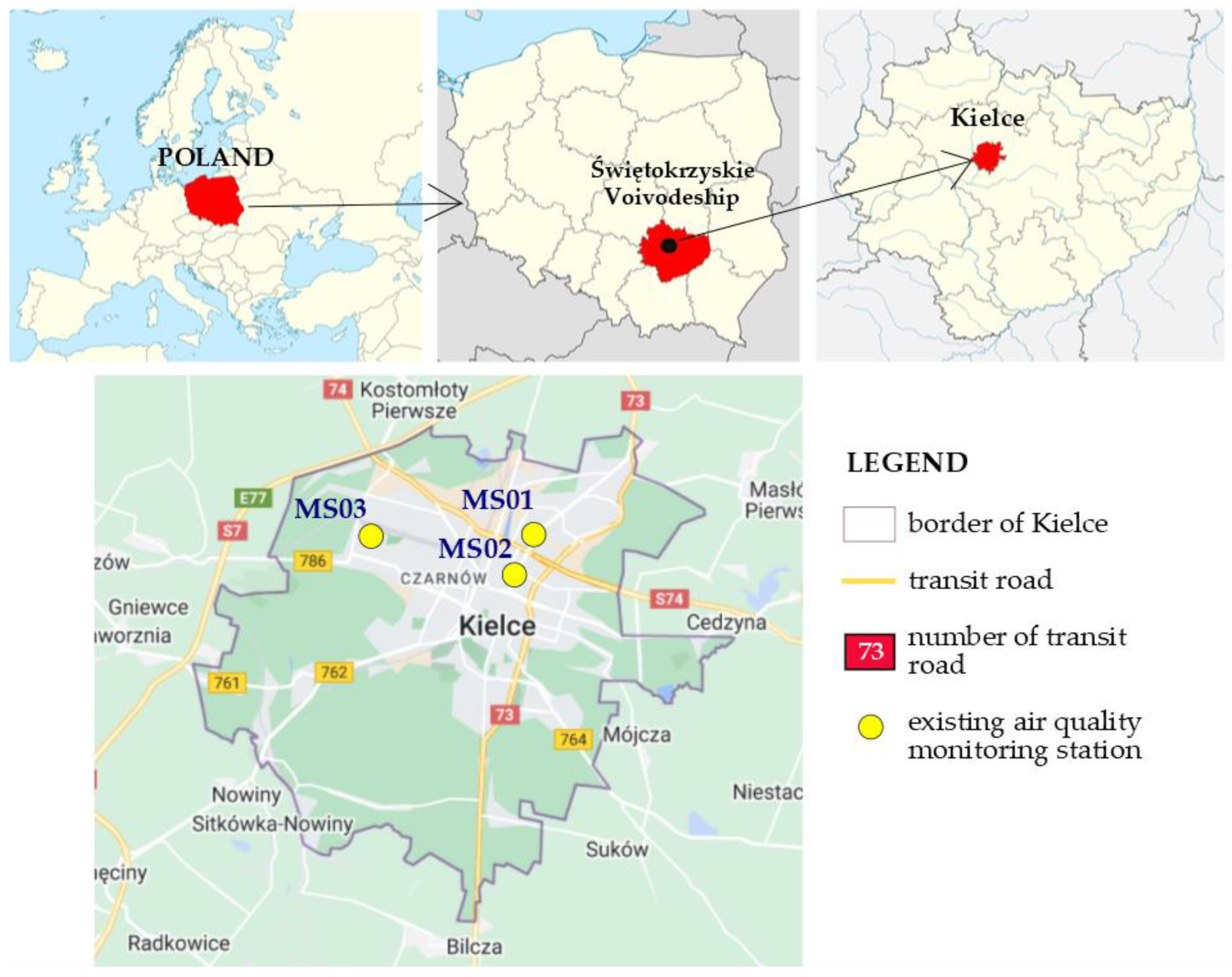
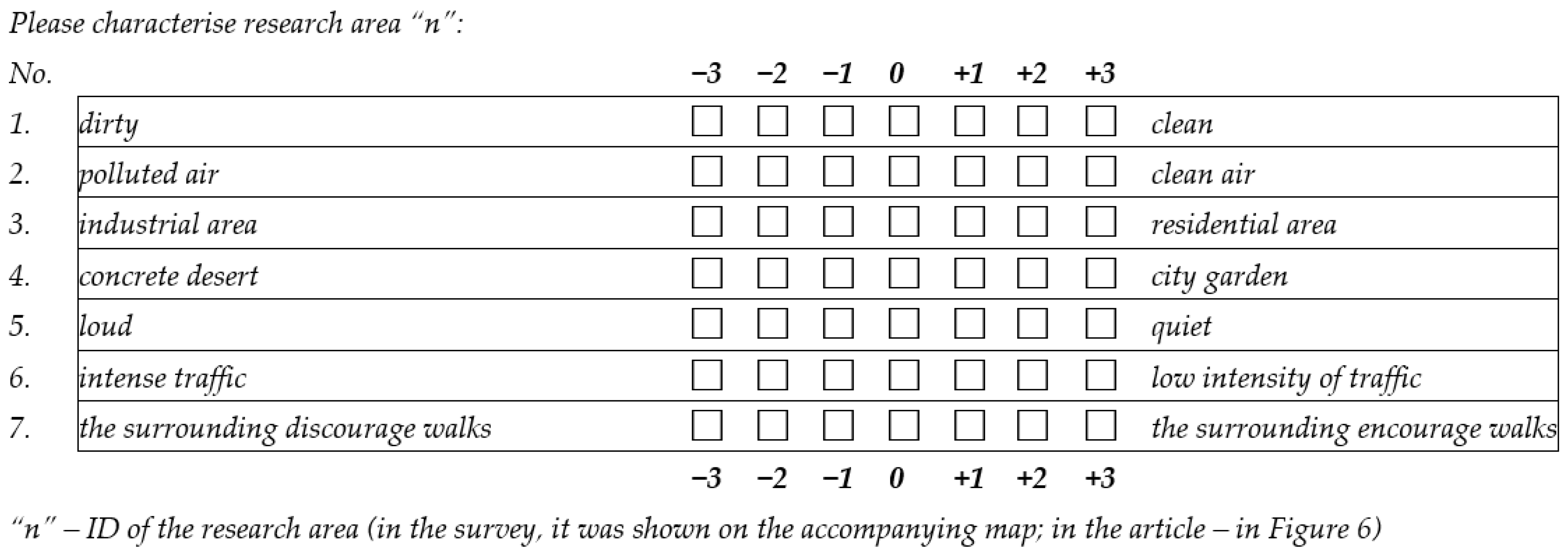
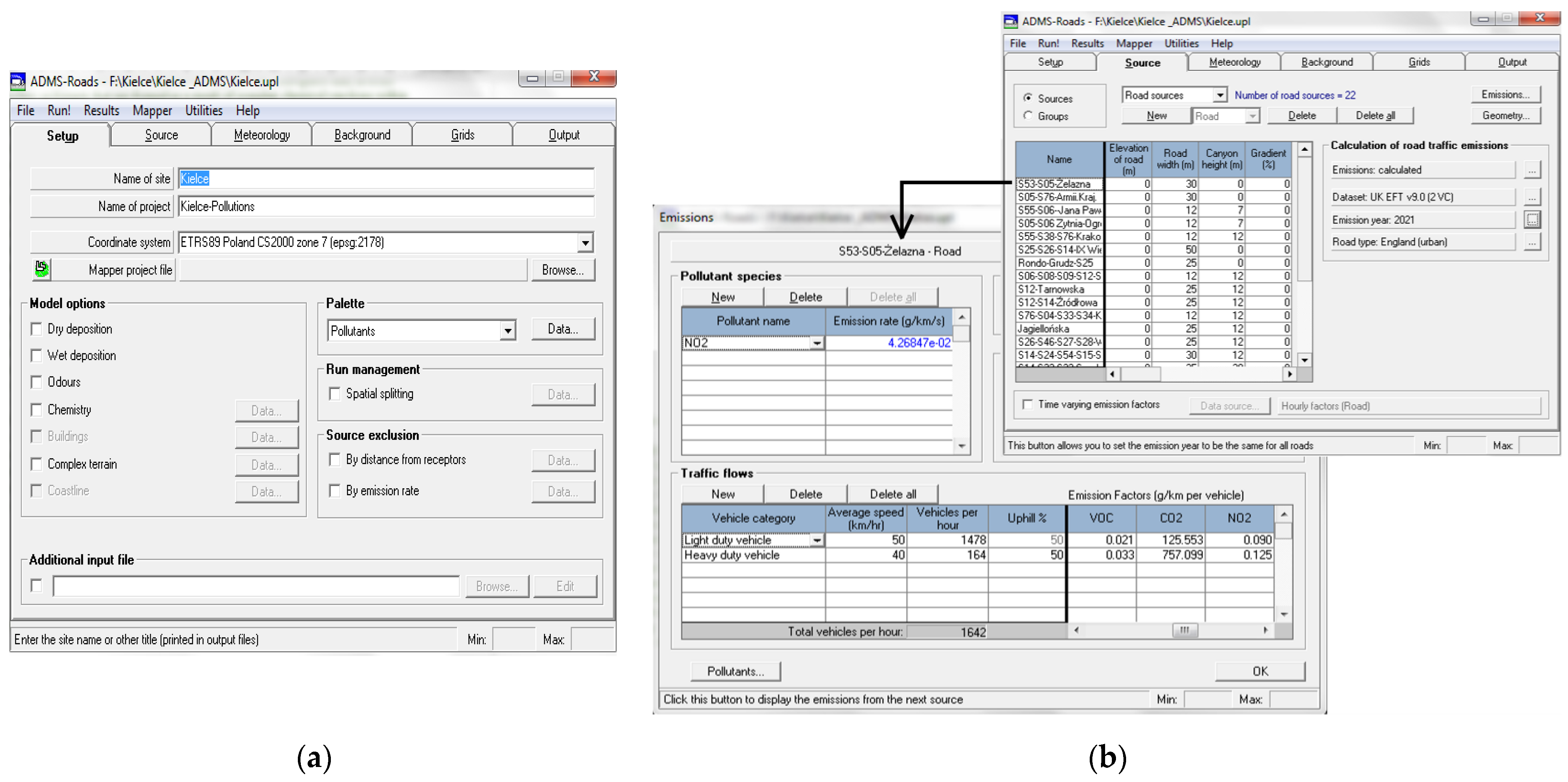
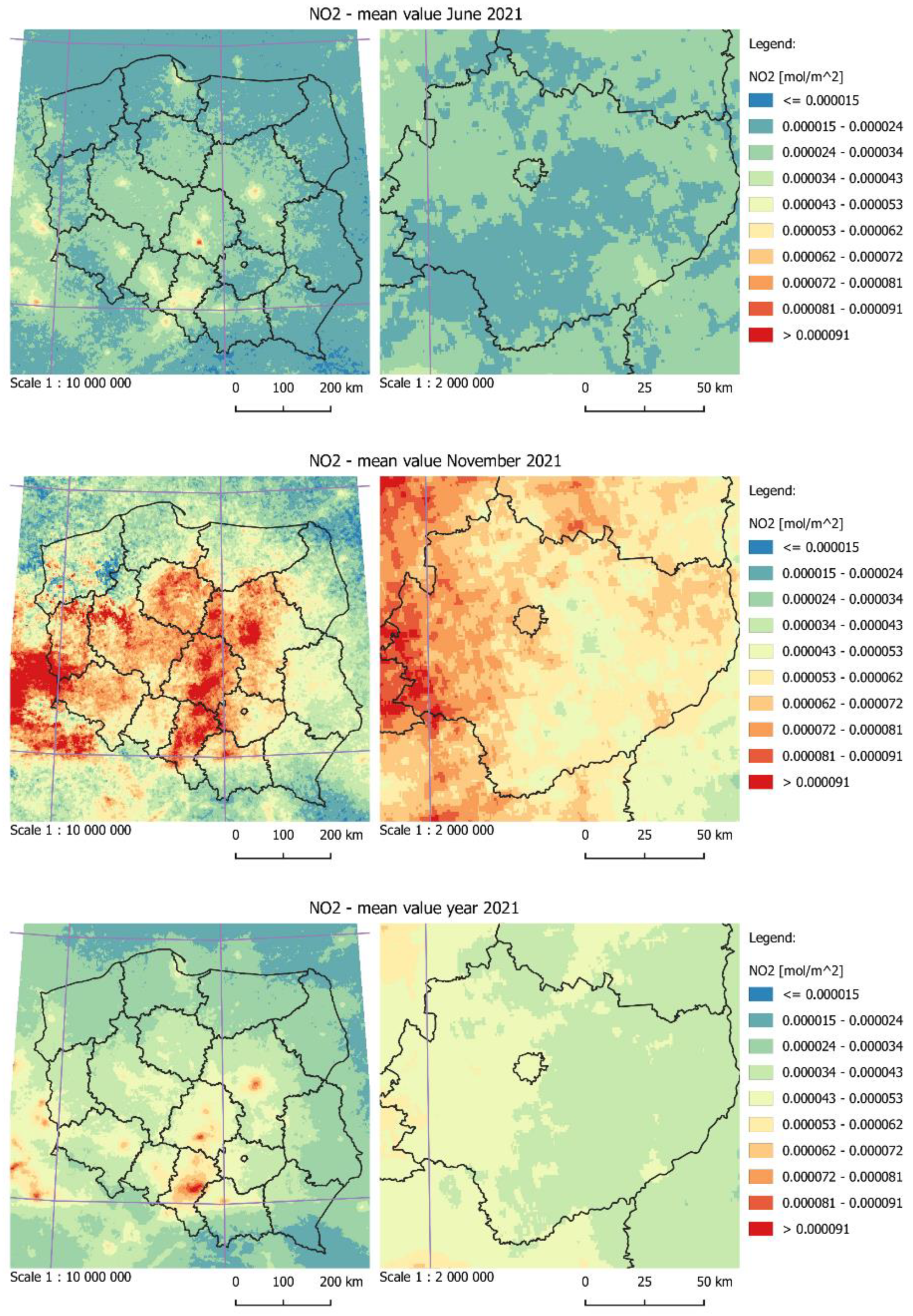

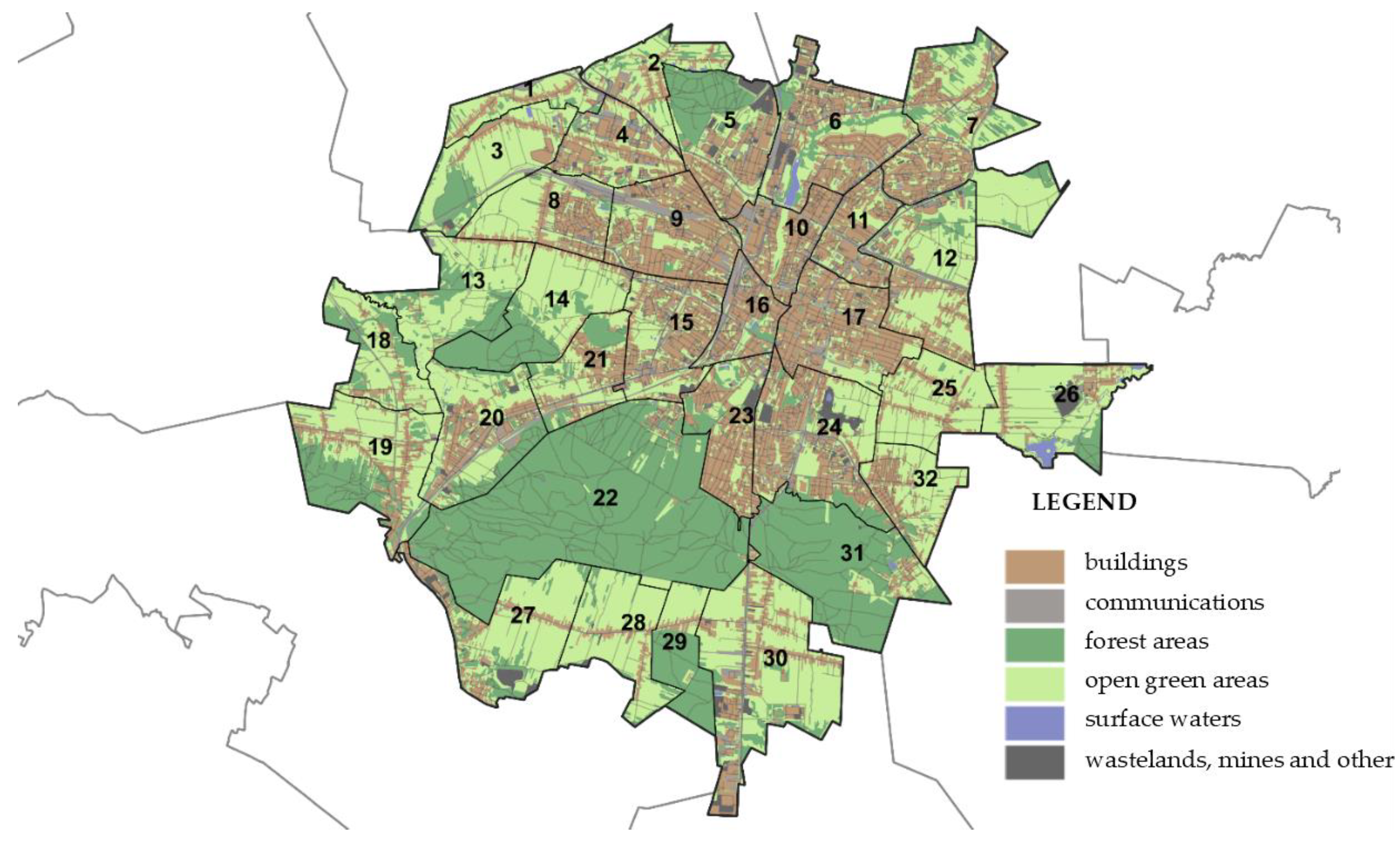
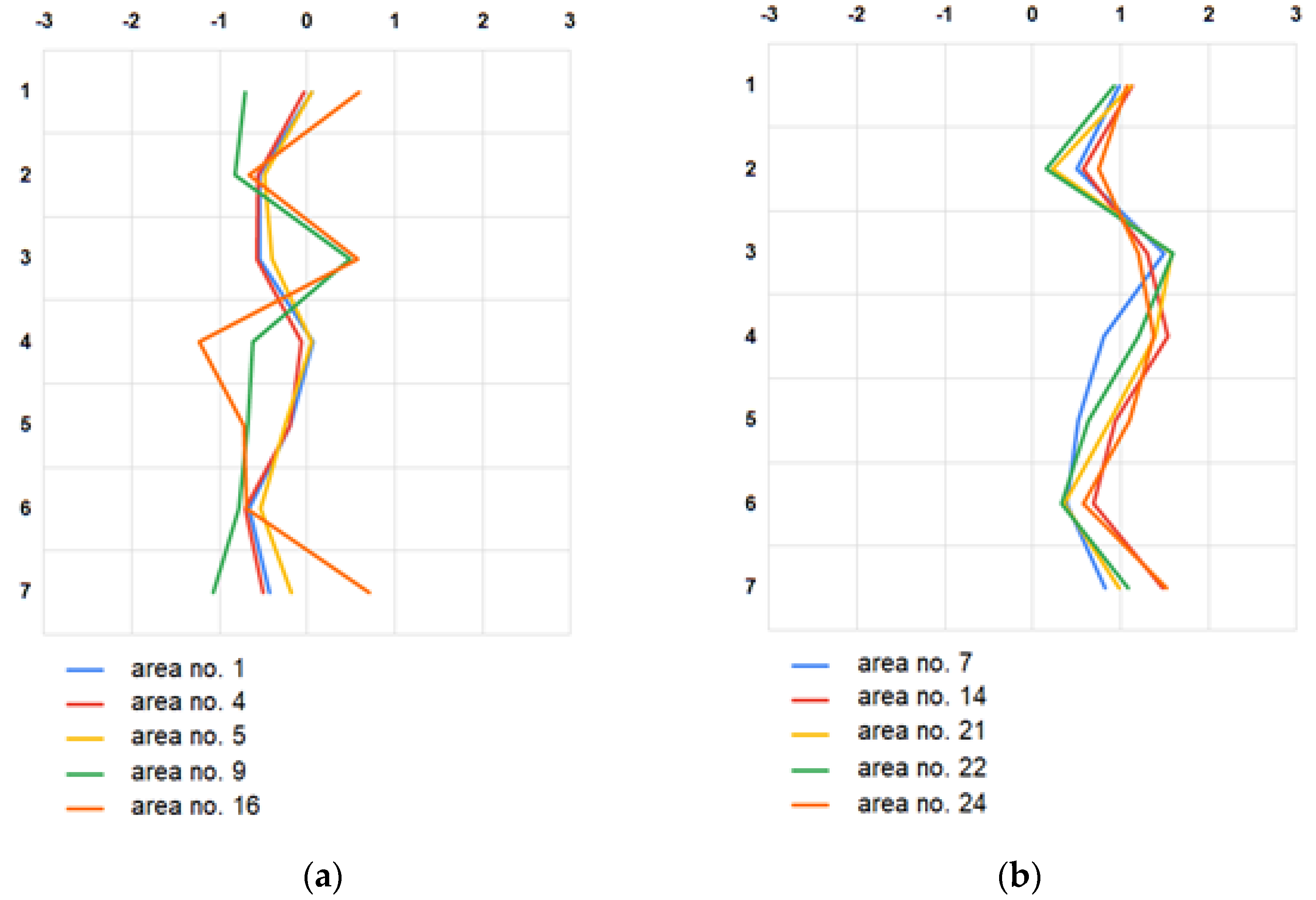
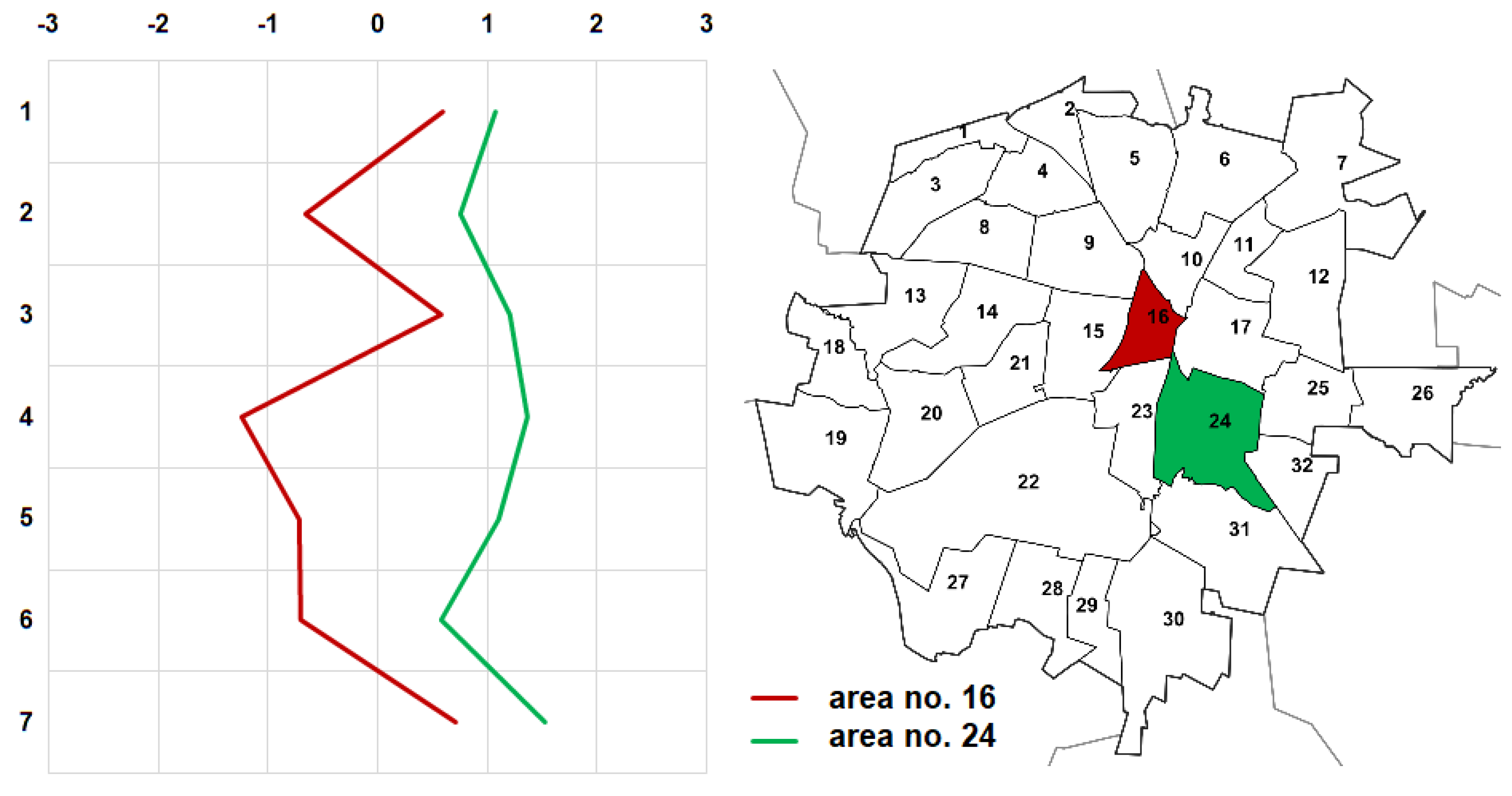
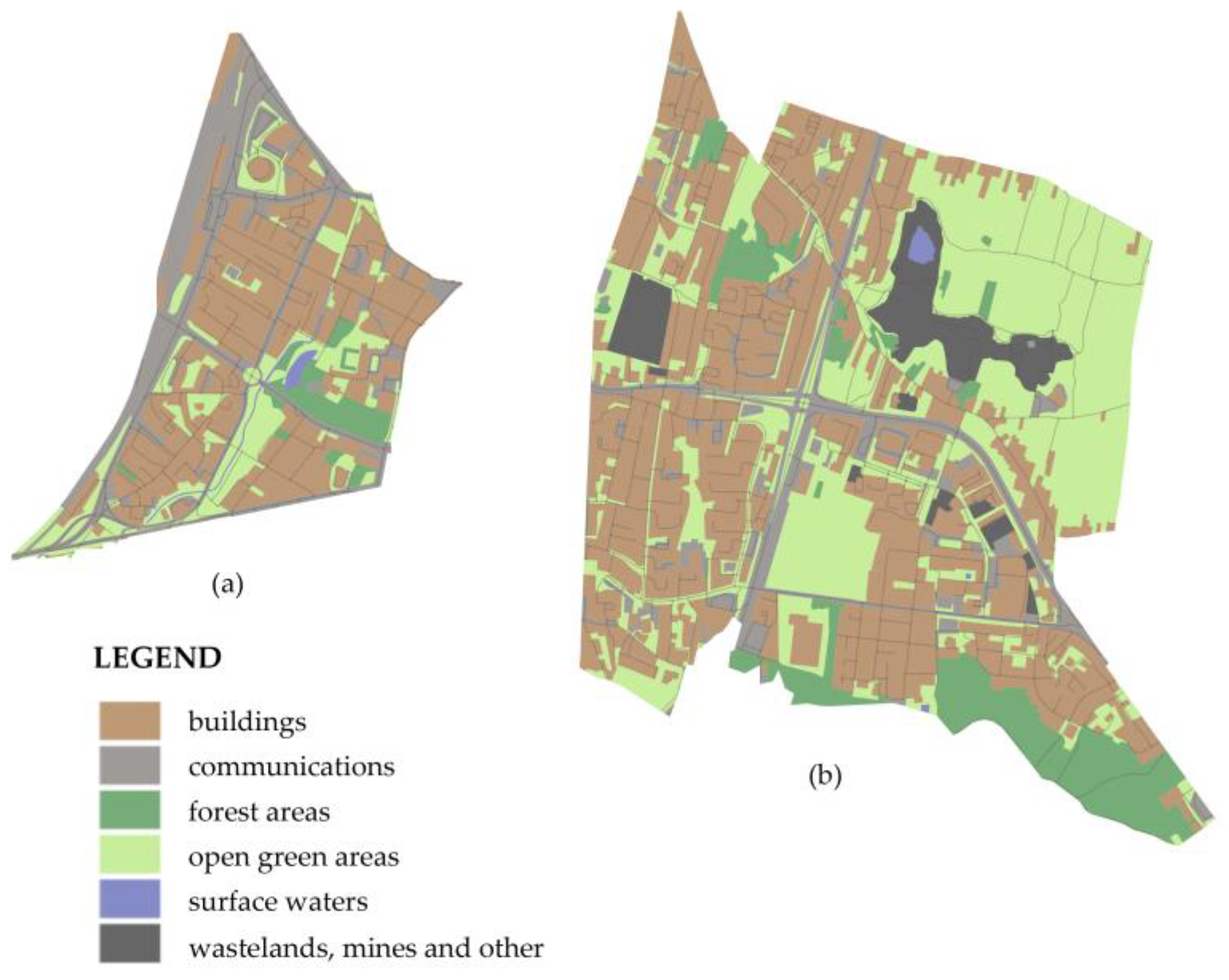
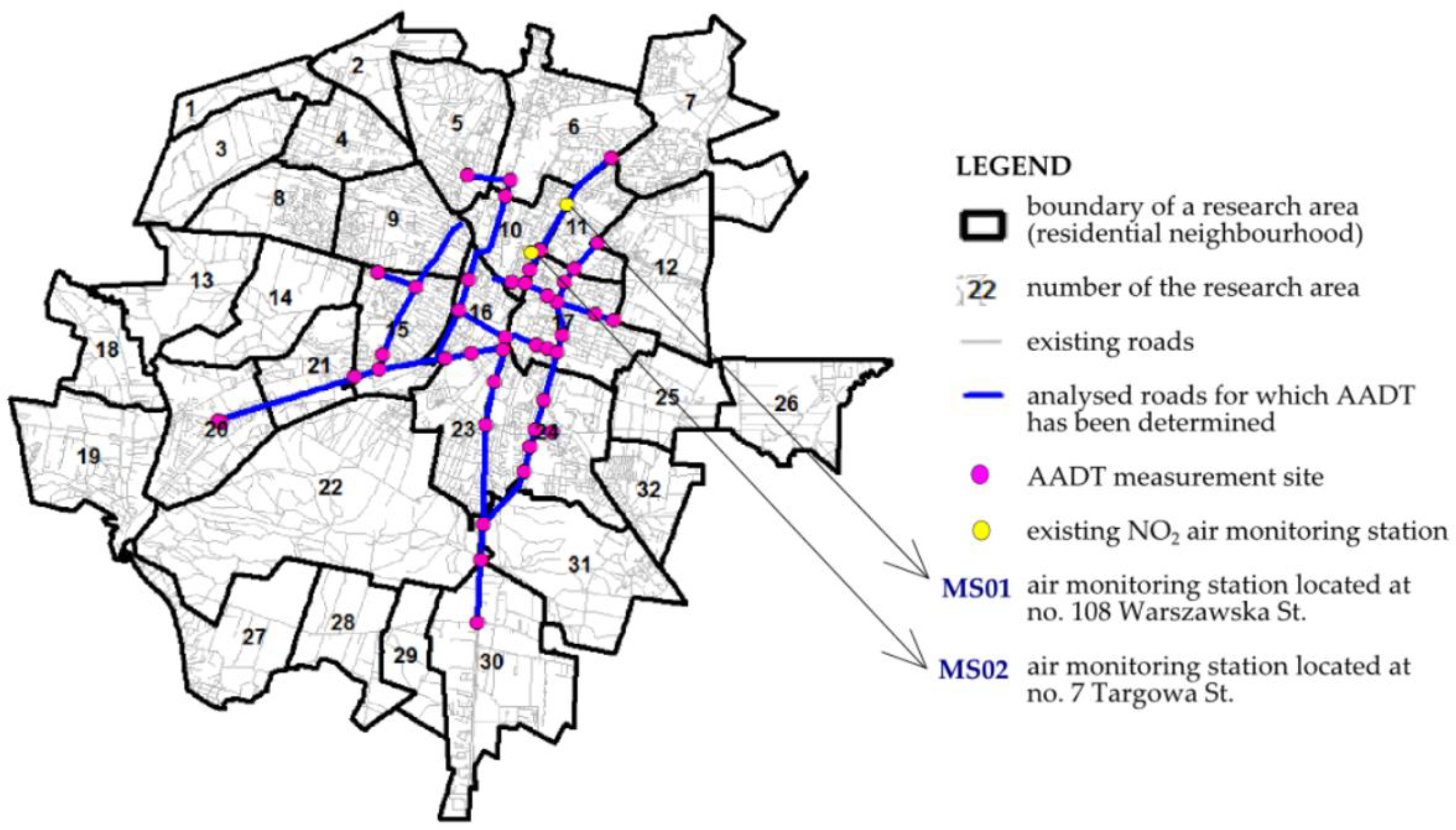

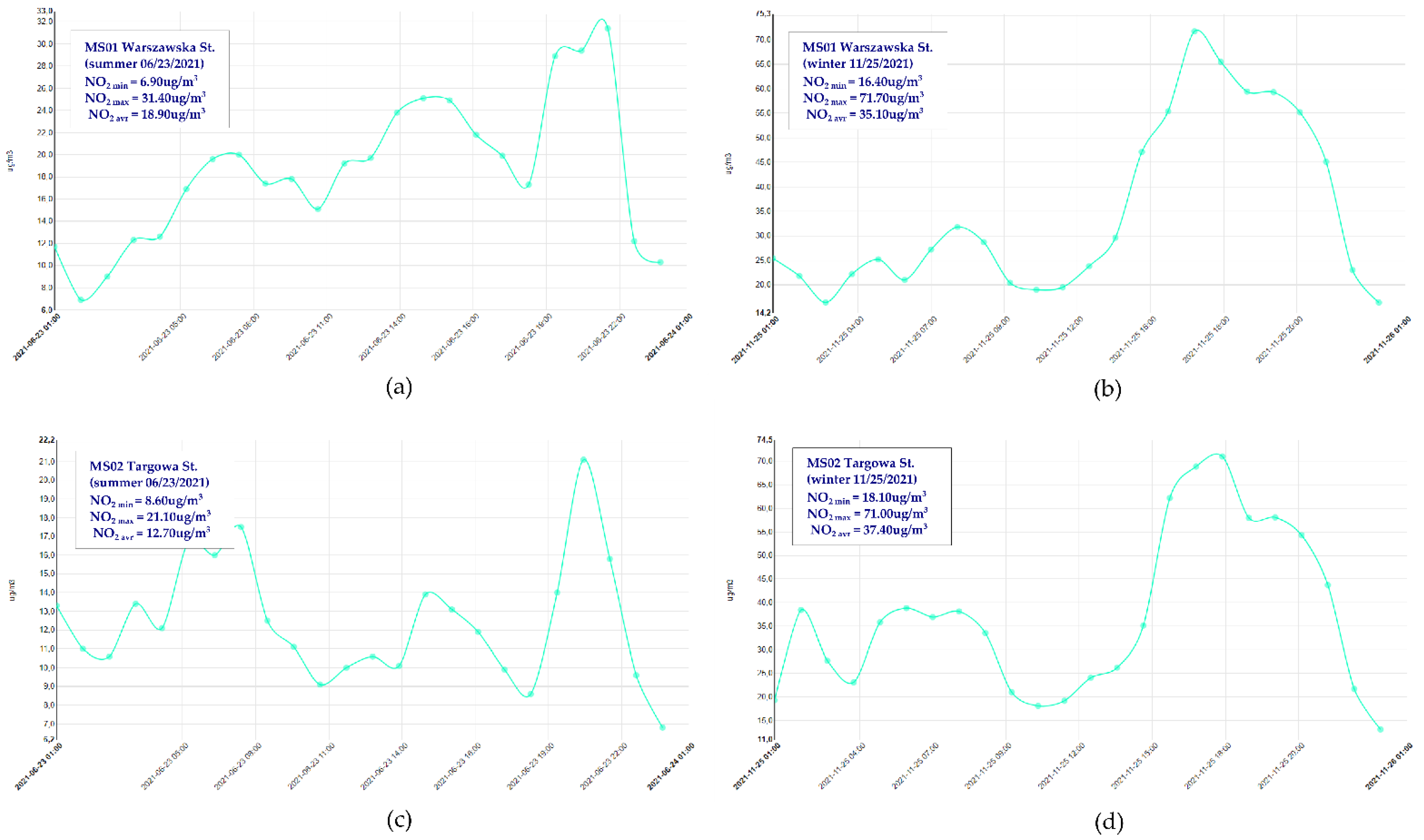
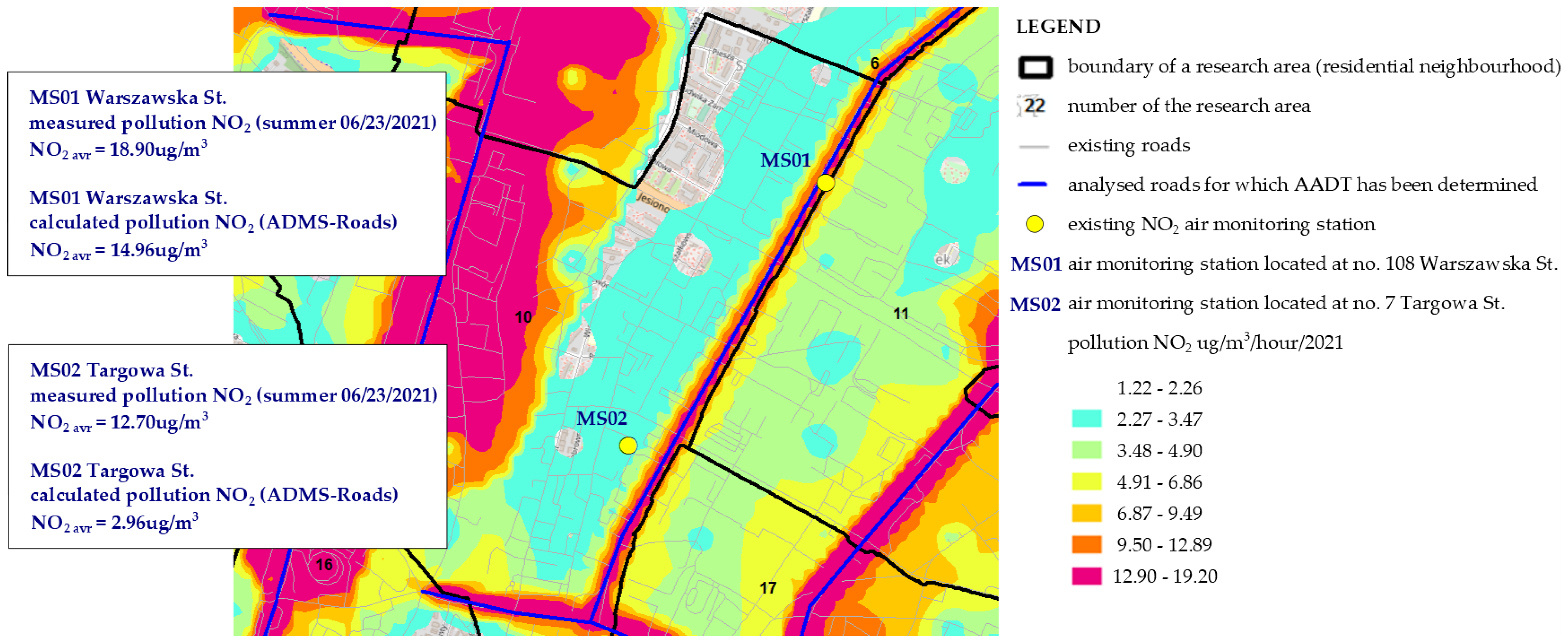
| No. | Location | Start Date of the Measurements | Measured Types of Pollutants |
|---|---|---|---|
| MS01 | no. 108 Warszawska St. | 1 January 2021 | nitrogen dioxide, benzene, carbon monoxide, PM10 |
| MS02 | no. 3 Targowa St. | 1 July 2018 | nitrogen dioxide, nitrogen oxides, sulfur dioxide, ozone, benzene, PM10, PM2.5, the presence of metals in PM10 |
| MS03 | no. 7 Jurajska St. | 1 January 2021 | PM10, benzo(a)pyrene in PM10 |
| Feature | Characteristic | Number | Value [%] |
|---|---|---|---|
| gender | female | 75 | 69.44 |
| male | 33 | 30.56 | |
| place of residence | Kielce | 89 | 82.41 |
| the nearest neighborhood of Kielce | 19 | 17.59 | |
| age (in years) | under 30 | 34 | 31.48 |
| 31–50 | 38 | 35.19 | |
| over 50 years old | 36 | 33.33 | |
| education | high school education | 18 | 16.67 |
| higher (university) | 90 | 83.33 | |
| air quality in Kielce | very good | 7 | 6.48 |
| good | 62 | 57.41 | |
| bad | 32 | 29.63 | |
| I can’t judge | 7 | 6.48 |
| No. | Span | Area | |||||||||||||||||||||||||||||||
|---|---|---|---|---|---|---|---|---|---|---|---|---|---|---|---|---|---|---|---|---|---|---|---|---|---|---|---|---|---|---|---|---|---|
| 1 | 2 | 3 | 4 | 5 | 6 | 7 | 8 | 9 | 10 | 11 | 12 | 13 | 14 | 15 | 16 | 17 | 18 | 19 | 20 | 21 | 22 | 23 | 24 | 25 | 26 | 27 | 28 | 29 | 30 | 31 | 32 | ||
| 1 | max | 1 | 2 | 0 | 0 | 0 | 1 | 19 | 6 | 0 | 1 | 10 | 0 | 0 | 8 | 0 | 15 | 1 | 2 | 1 | 1 | 2 | 11 | 11 | 8 | 1 | 1 | 0 | 0 | 0 | 2 | 1 | 3 |
| min | 2 | 4 | 0 | 2 | 3 | 2 | 0 | 2 | 40 | 1 | 5 | 3 | 0 | 0 | 4 | 18 | 0 | 2 | 2 | 6 | 1 | 0 | 5 | 0 | 1 | 2 | 0 | 1 | 1 | 0 | 1 | 0 | |
| 2 | max | 0 | 0 | 3 | 0 | 0 | 0 | 26 | 0 | 1 | 1 | 4 | 4 | 3 | 13 | 0 | 3 | 0 | 2 | 5 | 0 | 1 | 6 | 7 | 13 | 0 | 1 | 0 | 2 | 0 | 1 | 11 | 1 |
| min | 0 | 1 | 2 | 4 | 5 | 4 | 1 | 4 | 13 | 2 | 1 | 0 | 0 | 0 | 1 | 37 | 1 | 1 | 1 | 8 | 0 | 4 | 4 | 1 | 1 | 0 | 5 | 1 | 1 | 5 | 0 | 0 | |
| 3 | max | 0 | 1 | 0 | 0 | 0 | 0 | 3 | 21 | 1 | 3 | 12 | 0 | 0 | 1 | 2 | 44 | 2 | 0 | 0 | 0 | 0 | 1 | 11 | 2 | 0 | 1 | 0 | 0 | 1 | 1 | 1 | 0 |
| min | 1 | 10 | 4 | 2 | 1 | 4 | 8 | 3 | 5 | 0 | 3 | 2 | 1 | 1 | 0 | 6 | 0 | 4 | 3 | 4 | 0 | 7 | 2 | 0 | 2 | 8 | 5 | 6 | 3 | 7 | 5 | 1 | |
| 4 | max | 0 | 1 | 2 | 0 | 0 | 1 | 9 | 2 | 0 | 3 | 5 | 0 | 1 | 22 | 0 | 1 | 0 | 0 | 3 | 1 | 3 | 18 | 12 | 12 | 0 | 0 | 0 | 0 | 4 | 1 | 7 | 0 |
| min | 0 | 1 | 0 | 2 | 0 | 2 | 3 | 6 | 6 | 7 | 4 | 2 | 0 | 0 | 1 | 66 | 1 | 1 | 1 | 0 | 0 | 0 | 1 | 1 | 1 | 1 | 0 | 0 | 0 | 1 | 0 | 0 | |
| 5 | max | 1 | 2 | 1 | 1 | 1 | 0 | 16 | 1 | 1 | 1 | 2 | 2 | 1 | 19 | 0 | 0 | 0 | 2 | 2 | 2 | 4 | 13 | 5 | 9 | 3 | 4 | 1 | 1 | 3 | 2 | 5 | 3 |
| min | 0 | 1 | 1 | 5 | 3 | 1 | 3 | 3 | 16 | 7 | 2 | 0 | 0 | 0 | 0 | 52 | 4 | 0 | 0 | 1 | 0 | 1 | 4 | 0 | 0 | 0 | 2 | 0 | 0 | 1 | 1 | 0 | |
| 6 | max | 0 | 6 | 5 | 1 | 0 | 2 | 5 | 1 | 0 | 0 | 1 | 1 | 4 | 15 | 0 | 8 | 0 | 2 | 1 | 2 | 3 | 10 | 2 | 8 | 9 | 5 | 1 | 4 | 4 | 1 | 3 | 4 |
| min | 0 | 1 | 0 | 3 | 3 | 6 | 1 | 3 | 15 | 5 | 6 | 0 | 1 | 0 | 0 | 45 | 4 | 0 | 0 | 1 | 0 | 0 | 3 | 1 | 0 | 2 | 0 | 0 | 0 | 6 | 2 | 0 | |
| 7 | max | 0 | 1 | 1 | 1 | 0 | 0 | 5 | 7 | 0 | 3 | 9 | 1 | 0 | 8 | 0 | 29 | 0 | 2 | 2 | 0 | 3 | 14 | 11 | 5 | 1 | 1 | 0 | 0 | 1 | 1 | 1 | 1 |
| min | 0 | 4 | 2 | 3 | 1 | 3 | 3 | 3 | 27 | 5 | 4 | 2 | 1 | 2 | 1 | 3 | 4 | 4 | 3 | 6 | 0 | 3 | 2 | 2 | 1 | 6 | 1 | 3 | 2 | 7 | 0 | 0 | |
| 8 | max | 0 | 1 | 0 | 1 | 1 | 1 | 25 | 6 | 1 | 3 | 9 | 2 | 1 | 10 | 0 | 8 | 2 | 1 | 4 | 0 | 1 | 10 | 8 | 5 | 3 | 0 | 0 | 0 | 0 | 0 | 3 | 2 |
| min | 3 | 2 | 1 | 4 | 1 | 1 | 1 | 6 | 57 | 1 | 0 | 0 | 2 | 0 | 2 | 14 | 1 | 0 | 0 | 2 | 0 | 0 | 1 | 1 | 0 | 1 | 1 | 2 | 1 | 3 | 0 | 0 | |
| No. | Area | |||||||||||||||||||||||||||||||
|---|---|---|---|---|---|---|---|---|---|---|---|---|---|---|---|---|---|---|---|---|---|---|---|---|---|---|---|---|---|---|---|---|
| 1 | 2 | 3 | 4 | 5 | 6 | 7 | 8 | 9 | 10 | 11 | 12 | 13 | 14 | 15 | 16 | 17 | 18 | 19 | 20 | 21 | 22 | 23 | 24 | 25 | 26 | 27 | 28 | 29 | 30 | 31 | 32 | |
| 1 | 0.06 | 0.16 | 0.36 | −0.03 | 0.06 | 0.58 | 0.98 | 0.80 | −0.71 | 0.53 | 0.90 | 0.36 | 0.58 | 1.13 | 0.12 | 0.60 | 0.33 | 0.20 | 0.54 | 0.31 | 1.11 | 0.93 | 0.74 | 1.07 | 0.64 | 0.47 | 0.11 | 0.38 | 0.50 | 0.22 | 0.84 | 0.79 |
| 2 | −0.54 | 0.00 | 0.09 | −0.56 | −0.48 | −0.07 | 0.50 | 0.14 | −0.82 | −0.16 | 0.31 | −0.04 | 0.07 | 0.58 | −0.32 | −0.66 | 0.16 | 0.02 | −0.03 | −0.43 | 0.23 | 0.16 | −0.04 | 0.76 | 0.22 | −0.01 | −0.19 | −0.08 | 0.22 | −0.26 | 0.40 | 0.08 |
| 3 | −0.55 | 0.10 | 0.58 | −0.57 | −0.39 | 1.34 | 1.49 | 1.53 | 0.49 | 1.28 | 1.90 | 0.11 | 0.55 | 1.31 | 1.28 | 0.58 | 0.76 | 0.53 | 0.42 | −0.37 | 1.58 | 1.59 | 1.42 | 1.21 | 1.06 | 0.43 | 0.25 | 0.52 | 0.74 | −0.09 | 1.11 | 1.17 |
| 4 | 0.07 | 0.43 | 0.60 | −0.07 | 0.06 | 0.62 | 0.82 | 0.25 | −0.61 | 0.57 | 0.64 | 0.48 | 0.79 | 1.54 | 0.55 | −1.23 | 0.30 | 0.39 | 1.12 | 0.71 | 1.39 | 1.21 | 0.88 | 1.37 | 0.66 | 0.53 | 0.52 | 0.68 | 0.90 | 0.43 | 1.35 | 0.84 |
| 5 | −0.19 | 0.33 | 0.40 | −0.19 | −0.26 | 0.22 | 0.51 | 0.12 | −0.68 | 0.00 | 0.06 | 0.17 | 0.52 | 0.94 | 0.13 | −0.71 | 0.14 | 0.28 | 0.42 | 0.10 | 0.88 | 0.64 | 0.18 | 1.11 | 0.59 | 0.58 | 0.21 | 0.22 | 0.42 | −0.21 | 0.64 | 0.66 |
| 6 | −0.66 | 0.04 | 0.18 | −0.71 | −0.53 | −0.11 | 0.39 | −0.08 | −0.77 | −0.08 | 0.01 | −0.30 | 0.17 | 0.70 | −0.24 | −0.70 | −0.19 | 0.15 | −0.14 | −0.15 | 0.37 | 0.33 | −0.02 | 0.58 | 0.43 | 0.09 | −0.34 | −0.06 | −0.04 | −0.41 | 0.19 | 0.28 |
| 7 | −0.42 | 0.22 | 0.45 | −0.50 | −0.18 | 0.44 | 0.83 | 0.42 | −1.07 | 0.17 | 0.53 | 0.07 | 0.44 | 1.49 | 0.05 | 0.72 | 0.36 | 0.10 | 0.68 | 0.10 | 0.98 | 1.08 | 0.64 | 1.53 | 0.43 | 0.02 | −0.01 | 0.20 | 0.62 | −0.10 | 1.16 | 0.46 |
| No. | Area | |||||||||||||||||||||||||||||||
|---|---|---|---|---|---|---|---|---|---|---|---|---|---|---|---|---|---|---|---|---|---|---|---|---|---|---|---|---|---|---|---|---|
| 1 | 2 | 3 | 4 | 5 | 6 | 7 | 8 | 9 | 10 | 11 | 12 | 13 | 14 | 15 | 16 | 17 | 18 | 19 | 20 | 21 | 22 | 23 | 24 | 25 | 26 | 27 | 28 | 29 | 30 | 31 | 32 | |
| 1 | 0 | 0 | 0 | 0 | 0 | 1 | 1 | 1 | −1 | 1 | 1 | 0 | 0 | 1 | 0 | 1 | 0 | 0 | 0 | 0 | 1 | 1 | 1 | 1 | 1 | 0 | 0 | 0 | 0 | 0 | 1 | 1 |
| 2 | 0 | 0 | 0 | 0 | 0 | 0 | 1 | 0 | −1 | 0 | 0 | 0 | 0 | 1 | 0 | −1 | 0 | 0 | 0 | 0 | 0 | 0 | 0 | 1 | 0 | 0 | 0 | 0 | 0 | 0 | 0 | 0 |
| 3 | −1 | 0 | 0 | −1 | 0 | 2 | 2 | 2 | 0 | 2 | 2 | 0 | 0 | 2 | 1 | 0 | 1 | 0 | 0 | −1 | 2 | 2 | 2 | 1 | 1 | 0 | 0 | 0 | 0 | 0 | 1 | 2 |
| 4 | 0 | 0 | 0 | 0 | 0 | 1 | 1 | 0 | 0 | 1 | 1 | 0 | 1 | 2 | 1 | −1 | 0 | 0 | 1 | 1 | 1 | 1 | 1 | 2 | 1 | 1 | 0 | 1 | 1 | 0 | 2 | 1 |
| 5 | 0 | 0 | 0 | 0 | 0 | 0 | 0 | 0 | −1 | 0 | 0 | 0 | 0 | 1 | 0 | −1 | 0 | 0 | 0 | 0 | 1 | 1 | 0 | 1 | 0 | 0 | 0 | 0 | 0 | 0 | 1 | 1 |
| 6 | −1 | 0 | 0 | −1 | 0 | 0 | 0 | 0 | −1 | 0 | 0 | 0 | 0 | 1 | 0 | −1 | 0 | 0 | 0 | 0 | 0 | 0 | 0 | 0 | 1 | 0 | 0 | 0 | 0 | 0 | 0 | 0 |
| 7 | 0 | 0 | 0 | 0 | 0 | 1 | 1 | 0 | −1 | 0 | 1 | 0 | 0 | 2 | 0 | 1 | 0 | 0 | 1 | 0 | 1 | 1 | 1 | 2 | 0 | 0 | 0 | 0 | 1 | 0 | 1 | 0 |
| No. | Area | |||||||||||||||||||||||||||||||
|---|---|---|---|---|---|---|---|---|---|---|---|---|---|---|---|---|---|---|---|---|---|---|---|---|---|---|---|---|---|---|---|---|
| 1 | 2 | 3 | 4 | 5 | 6 | 7 | 8 | 9 | 10 | 11 | 12 | 13 | 14 | 15 | 16 | 17 | 18 | 19 | 20 | 21 | 22 | 23 | 24 | 25 | 26 | 27 | 28 | 29 | 30 | 31 | 32 | |
| 1 | 1.34 | 1.28 | 1.17 | 1.34 | 1.35 | 1.30 | 1.45 | 1.42 | 1.63 | 1.43 | 1.37 | 1.42 | 1.20 | 1.43 | 1.44 | 1.39 | 1.32 | 1.44 | 1.31 | 1.21 | 1.28 | 1.27 | 1.31 | 1.38 | 1.35 | 1.30 | 1.40 | 1.30 | 1.24 | 1.39 | 1.15 | 1.26 |
| 2 | 1.37 | 1.43 | 1.48 | 1.40 | 1.28 | 1.50 | 1.67 | 1.58 | 1.40 | 1.36 | 1.52 | 1.38 | 1.41 | 1.55 | 1.33 | 1.58 | 1.25 | 1.41 | 1.54 | 1.56 | 1.59 | 1.75 | 1.68 | 1.53 | 1.55 | 1.42 | 1.40 | 1.33 | 1.43 | 1.45 | 1.56 | 1.51 |
| 3 | 1.50 | 1.50 | 1.36 | 1.57 | 1.51 | 1.60 | 1.49 | 1.57 | 1.57 | 1.54 | 1.34 | 1.64 | 1.26 | 1.40 | 1.34 | 1.60 | 1.47 | 1.20 | 1.56 | 1.74 | 1.28 | 1.47 | 1.49 | 1.54 | 1.43 | 1.45 | 1.58 | 1.49 | 1.35 | 1.77 | 1.49 | 1.56 |
| 4 | 1.24 | 1.36 | 1.40 | 1.31 | 1.30 | 1.29 | 1.59 | 1.50 | 1.42 | 1.43 | 1.44 | 1.21 | 1.32 | 1.49 | 1.22 | 1.48 | 1.36 | 1.31 | 1.27 | 1.29 | 1.27 | 1.41 | 1.31 | 1.43 | 1.38 | 1.32 | 1.26 | 1.27 | 1.46 | 1.42 | 1.33 | 1.28 |
| 5 | 1.37 | 1.34 | 1.24 | 1.34 | 1.47 | 1.53 | 1.68 | 1.68 | 1.42 | 1.52 | 1.52 | 1.49 | 1.19 | 1.58 | 1.28 | 1.69 | 1.39 | 1.34 | 1.45 | 1.48 | 1.34 | 1.59 | 1.52 | 1.54 | 1.45 | 1.36 | 1.38 | 1.35 | 1.51 | 1.46 | 1.32 | 1.44 |
| 6 | 1.32 | 1.46 | 1.47 | 1.40 | 1.43 | 1.59 | 1.66 | 1.74 | 1.58 | 1.55 | 1.57 | 1.31 | 1.29 | 1.53 | 1.49 | 1.88 | 1.38 | 1.37 | 1.46 | 1.58 | 1.52 | 1.58 | 1.51 | 1.55 | 1.35 | 1.57 | 1.35 | 1.39 | 1.48 | 1.59 | 1.51 | 1.32 |
| 7 | 1.45 | 1.44 | 1.35 | 1.43 | 1.38 | 1.43 | 1.49 | 1.66 | 1.53 | 1.48 | 1.54 | 1.48 | 1.30 | 1.43 | 1.39 | 1.61 | 1.38 | 1.26 | 1.46 | 1.57 | 1.52 | 1.64 | 1.61 | 1.55 | 1.47 | 1.45 | 1.38 | 1.33 | 1.41 | 1.43 | 1.29 | 1.50 |
| Name of the Street | Road Category 1 | Road Width [m] | Speed [km/h] | AADT [n/h] | Heavy Vehicles [n/h] | Building Height [m] | Height Group of Buildings 2 | Type of Building Design 3 |
|---|---|---|---|---|---|---|---|---|
| Streets belonging to area no. 16 | ||||||||
| Żelazna | W | 30 | 50 | 1642 | 164 | none | none | none |
| Armii Krajowej | W | 30 | 50 | 656 | 65 | none | none | none |
| Jana Pawła II | P | 12 | 50 | 1540 | 154 | 7 | N | Z |
| Żytnia | G | 12 | 50 | 1140 | 114 | 7 | N | R |
| Krakowska | P | 12 | 50 | 433 | 43 | 12 | N | R |
| Krakowska | W | 12 | 50 | 1739 | 261 | 12 | N | R |
| Streets belonging to area no. 24 | ||||||||
| Tarnowska | K | 25 | 50 | 1119 | 111 | 12 | N | R |
| Popiełuszki | K | 25 | 70 | 1214 | 182 | 12 | N | R |
| Ściegiennego | P | 12 | 40 | 1562 | 156 | 7 | N | R |
| Streets belonging to the remaining areas | ||||||||
| IX Wieków Kielc | G | 50 | 50 | 799 | 80 | 12 | N | R |
| Seminaryjna | G | 12 | 40 | 484 | 48 | 12 | N | Z |
| Źródłowa | K | 25 | 50 | 2019 | 302 | 12 | N | R |
| Jagiellońska | P | 25 | 50 | 342 | 34 | 12 | N | R |
| Warszawska | P | 25 | 50 | 662 | 65 | 12 | N | R |
| Solidarności | K | 30 | 50 | 1745 | 261 | 12 | N | R |
| Sandomierska | G | 25 | 50 | 502 | 50 | 20 | SW | R |
| Zagnańska | K | 30 | 50 | 1679 | 168 | 7 | N | R |
| Łódzka | K | 25 | 50 | 1785 | 178 | 7 | N | R |
| Grunwaldzka | W | 25 | 50 | 1600 | 160 | 12 | N | R |
| W. Pileckiego | W | 30 | 50 | 917 | 46 | 12 | N | R |
Publisher’s Note: MDPI stays neutral with regard to jurisdictional claims in published maps and institutional affiliations. |
© 2022 by the authors. Licensee MDPI, Basel, Switzerland. This article is an open access article distributed under the terms and conditions of the Creative Commons Attribution (CC BY) license (https://creativecommons.org/licenses/by/4.0/).
Share and Cite
Szopińska, K.; Cienciała, A.; Bieda, A.; Kwiecień, J.; Kulesza, Ł.; Parzych, P. Verification of the Perception of the Local Community concerning Air Quality Using ADMS-Roads Modeling. Int. J. Environ. Res. Public Health 2022, 19, 10908. https://doi.org/10.3390/ijerph191710908
Szopińska K, Cienciała A, Bieda A, Kwiecień J, Kulesza Ł, Parzych P. Verification of the Perception of the Local Community concerning Air Quality Using ADMS-Roads Modeling. International Journal of Environmental Research and Public Health. 2022; 19(17):10908. https://doi.org/10.3390/ijerph191710908
Chicago/Turabian StyleSzopińska, Kinga, Agnieszka Cienciała, Agnieszka Bieda, Janusz Kwiecień, Łukasz Kulesza, and Piotr Parzych. 2022. "Verification of the Perception of the Local Community concerning Air Quality Using ADMS-Roads Modeling" International Journal of Environmental Research and Public Health 19, no. 17: 10908. https://doi.org/10.3390/ijerph191710908
APA StyleSzopińska, K., Cienciała, A., Bieda, A., Kwiecień, J., Kulesza, Ł., & Parzych, P. (2022). Verification of the Perception of the Local Community concerning Air Quality Using ADMS-Roads Modeling. International Journal of Environmental Research and Public Health, 19(17), 10908. https://doi.org/10.3390/ijerph191710908










